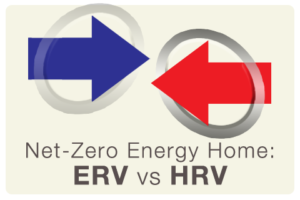ERV vs HRV: Which is Better for Net-Zero Energy Homes?
 When building a net-zero energy home, there are so many factors to take into consideration that it can be confusing to know where to start. Each detail has to be meticulously planned to ensure your home is as energy efficient as possible. This process can be highly stressful, but the savings in the long run, are worth it.
When building a net-zero energy home, there are so many factors to take into consideration that it can be confusing to know where to start. Each detail has to be meticulously planned to ensure your home is as energy efficient as possible. This process can be highly stressful, but the savings in the long run, are worth it.
One decision that homebuilders have to make is choosing ERV vs HRV systems to provide your home with fresh, filtered air. They are balanced ventilation systems that, though more expensive to install than other mechanical ventilation systems, save homeowners in Arizona a lot on operating costs, which is why they are commonly used in net-zero homes. Both are highly energy efficient, but what are the differences?
ERV Filtration System
An energy-recovery ventilator (ERV) operates essentially the same as an HRV while also dealing with the home’s humidity. It will take some of the moisture from the more humid air stream and transfer it to the dryer air stream, which in most cases does not cause cross-contamination of air streams.
HRV Filtration System
A heat-recovery ventilator (HRV) exhausts stale air from the home while at the same time pulling in fresh air. Stale air is generally removed from rooms with the most moisture—bathrooms and laundry rooms—while fresh air is pumped into the most-used rooms, like the living room and bedrooms. Since both these air streams pass through the same ventilator, heat from whichever stream is warmer (fresh air in summer, stale air in winter) is “recovered” and transferred to the other airstream without the two airflows mixing.
Air Ventilation in Hot Climates
Both HRVs and ERVs need air conditioning in order to properly ventilate homes during the summer. This is because a heat exchange must occur in order for ventilation to happen. The incoming air from the outside must be warmer than the outgoing exhaust air from the inside, which won’t be the case if the indoor air isn’t being cooled by an air conditioner. Thankfully, home air conditioning in Phoenix isn’t generally a problem, as families depend on it for both comfort and safety during hot summer months.
Which System is Right for My Home?
Net-Zero energy home ventilation systems have different operating costs depending mainly on the climate and airflow. If you are building a net zero home from the ground up, airflow should be tight and well maintained—you’ll have much more control over your home’s energy leaking than if you were to refurbish an old Victorian house. Based on the dry climates that most Arizona homeowners are used to, it’s likely that either an ERV or an HRV will be a good choice.
Both ERV and HRV systems are good—your contractor will be able to make the best recommendation based on your home building specifics. For custom zero energy home building in Scottsdale, Peak One Builders provides expertise on all aspects of the home building process, right down to which ventilation system is right for your home.
______________________________________________
Contact the Net-Zero Energy home building experts at Peak One Builders & Restoration to learn more about creating a custom cutting-edge green home. Request a free estimate or call (480) 569-7977 now!


